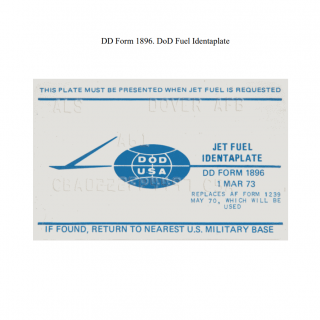DD Form 1896. DoD Fuel Identaplate
DD Form 1896, also known as the DoD Fuel Identaplate, is a form used by the US military to identify and track military fuel containers and tanks. The main purpose of this form is to ensure that fuel containers and tanks are properly labeled and tracked to prevent contamination, misidentification, or theft.
The form consists of several parts, including the identification number, the date of installation, the type of fuel, the capacity of the container or tank, and the name of the person or organization responsible for the container or tank. The important fields to consider when filling out this form include the identification number and the type of fuel, as these are crucial for accurate tracking and identification.
The parties involved in this form include the military unit responsible for the fuel container or tank, as well as any logistics or transportation personnel who handle the fuel. It is important to consider the safety and security of the fuel and the potential impact on mission readiness when filling out this form.
When writing this form, the data required includes the identification number, the date of installation, the type of fuel, the capacity of the container or tank, and the name of the person or organization responsible for the container or tank. Additionally, any supporting documentation or inspection reports may need to be attached to the form.
Application examples and practice and use cases for this form include tracking fuel containers and tanks during transportation or storage, ensuring proper labeling and identification of fuel sources, and maintaining accurate records of fuel usage and inventory. The strengths of this form include its ability to prevent fuel contamination or theft and ensure mission readiness. However, weaknesses may include the potential for human error or incomplete documentation.
Related forms to DD Form 1896 include DD Form 1898, which is used for fuel quality control, and DD Form 1897, which is used for petroleum analysis. The main difference between these forms is their specific focus on fuel quality control and analysis, rather than identification and tracking.
The accurate recording of information on this form can affect the future of the military unit by ensuring that fuel sources are properly identified, tracked, and protected. This form is typically submitted to the commanding officer of the unit and is stored in the unit's records for future reference and tracking.

